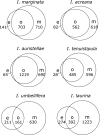Quantitative and qualitative shifts in defensive metabolites define chemical defense investment during leaf development in Inga, a genus of tropical trees
- PMID: 26843932
- PMCID: PMC4729263
- DOI: 10.1002/ece3.1896
Quantitative and qualitative shifts in defensive metabolites define chemical defense investment during leaf development in Inga, a genus of tropical trees
Abstract
Selective pressures imposed by herbivores are often positively correlated with investments that plants make in defense. Research based on the framework of an evolutionary arms race has improved our understanding of why the amount and types of defenses differ between plant species. However, plant species are exposed to different selective pressures during the life of a leaf, such that expanding leaves suffer more damage from herbivores and pathogens than mature leaves. We hypothesize that this differential selective pressure may result in contrasting quantitative and qualitative defense investment in plants exposed to natural selective pressures in the field. To characterize shifts in chemical defenses, we chose six species of Inga, a speciose Neotropical tree genus. Focal species represent diverse chemical, morphological, and developmental defense traits and were collected from a single site in the Amazonian rainforest. Chemical defenses were measured gravimetrically and by characterizing the metabolome of expanding and mature leaves. Quantitative investment in phenolics plus saponins, the major classes of chemical defenses identified in Inga, was greater for expanding than mature leaves (46% and 24% of dry weight, respectively). This supports the theory that, because expanding leaves are under greater selective pressure from herbivores, they rely more upon chemical defense as an antiherbivore strategy than do mature leaves. Qualitatively, mature and expanding leaves were distinct and mature leaves contained more total and unique metabolites. Intraspecific variation was greater for mature leaves than expanding leaves, suggesting that leaf development is canalized. This study provides a snapshot of chemical defense investment in a speciose genus of tropical trees during the short, few-week period of leaf development. Exploring the metabolome through quantitative and qualitative profiling enables a more comprehensive examination of foliar chemical defense investment.
Keywords: Foliar chemistry; Inga; leaf development; metabolomics; plant defense traits; secondary metabolites.
Figures





Similar articles
-
High herbivore pressure favors constitutive over induced defense.Ecol Evol. 2016 Jul 29;6(17):6037-49. doi: 10.1002/ece3.2208. eCollection 2016 Sep. Ecol Evol. 2016. PMID: 27648224 Free PMC article.
-
Do the antiherbivore traits of expanding leaves in the Neotropical tree Inga paraensis (Fabaceae) vary with light availability?Oecologia. 2012 Nov;170(3):669-76. doi: 10.1007/s00442-012-2353-5. Epub 2012 May 22. Oecologia. 2012. PMID: 22614262
-
Consequences of interspecific variation in defenses and herbivore host choice for the ecology and evolution of Inga, a speciose rainforest tree.Oecologia. 2018 Jun;187(2):361-376. doi: 10.1007/s00442-018-4080-z. Epub 2018 Feb 10. Oecologia. 2018. PMID: 29428967 Review.
-
The evolution of antiherbivore defenses and their contribution to species coexistence in the tropical tree genus Inga.Proc Natl Acad Sci U S A. 2009 Oct 27;106(43):18073-8. doi: 10.1073/pnas.0904786106. Epub 2009 Sep 21. Proc Natl Acad Sci U S A. 2009. PMID: 19805183 Free PMC article.
-
Contrasting mechanisms of secondary metabolite accumulation during leaf development in two tropical tree species with different leaf expansion strategies.Oecologia. 2006 Aug;149(1):91-100. doi: 10.1007/s00442-006-0423-2. Epub 2006 May 5. Oecologia. 2006. PMID: 16676208
Cited by
-
Tracking of Host Defenses and Phylogeny During the Radiation of Neotropical Inga-Feeding Sawflies (Hymenoptera; Argidae).Front Plant Sci. 2018 Aug 23;9:1237. doi: 10.3389/fpls.2018.01237. eCollection 2018. Front Plant Sci. 2018. PMID: 30190723 Free PMC article.
-
High herbivore pressure favors constitutive over induced defense.Ecol Evol. 2016 Jul 29;6(17):6037-49. doi: 10.1002/ece3.2208. eCollection 2016 Sep. Ecol Evol. 2016. PMID: 27648224 Free PMC article.
-
Growing Season Lengthens in a North American Deciduous Woody Community From 1993 to 2021.Ecol Evol. 2025 May 19;15(5):e71226. doi: 10.1002/ece3.71226. eCollection 2025 May. Ecol Evol. 2025. PMID: 40391119 Free PMC article.
-
A comparison of inducible, ontogenetic, and interspecific sources of variation in the foliar metabolome in tropical trees.PeerJ. 2019 Sep 20;7:e7536. doi: 10.7717/peerj.7536. eCollection 2019. PeerJ. 2019. PMID: 31579568 Free PMC article.
-
Hydroxyacetophenone defenses in white spruce against spruce budworm.Evol Appl. 2019 Dec 20;13(1):62-75. doi: 10.1111/eva.12885. eCollection 2020 Jan. Evol Appl. 2019. PMID: 31892944 Free PMC article.
References
-
- Abdala‐Roberts, L. , Moreira X., Cervera J. C., and Parra‐Tabla V.. 2014. Light availability influences growth‐defense trade‐offs in big‐leaf mahogany (Swietenia macrophylla King). Biotropica 46:591–597.
-
- Agrawal, A. A. , and Karban R.. 1999. Why induced defenses may be favored over constitutive strategies in plants Pp. 45–61 in Tollrian R. and Harvell C. D. ed. The ecology and evolution of inducible defenses. Princeton University Press, Princeton.
-
- Aide, T. , and Londoño E.. 1989. The effects of rapid leaf expansion on the growth and survivorship of a lepidopteran herbivore. Oikos 55:66–70.
-
- Barton, K. E. , and Koricheva J.. 2010. The ontogeny of plant defense and herbivory: characterizing general patterns using meta‐analysis. Am. Nat. 175:481–493. - PubMed
LinkOut - more resources
Full Text Sources
Other Literature Sources

